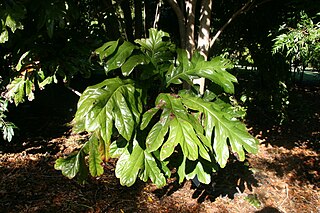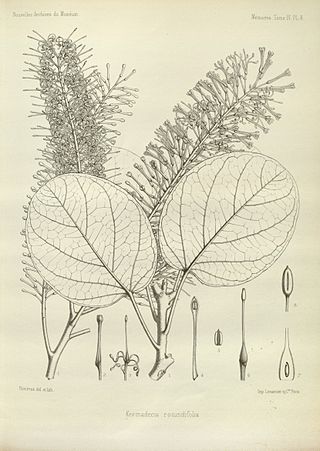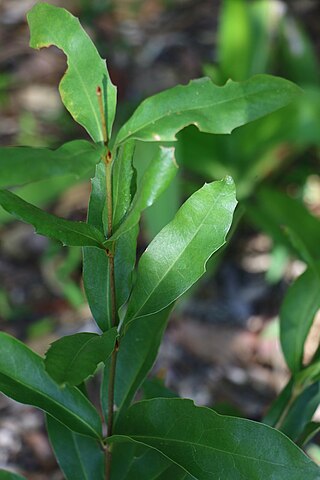
Macadamia is a genus of four species of trees in the flowering plant family Proteaceae. They are indigenous to Australia, native to northeastern New South Wales and central and southeastern Queensland specifically. Two species of the genus are commercially important for their fruit, the macadamia nut. Global production in 2015 was 160,000 tonnes. Other names include Queensland nut, bush nut, maroochi nut, bauple nut and, in the USA, they are also known as Hawaii nut. In Australian Aboriginal languages, the fruit is known by names such as bauple, gyndl or jindilli and boombera. It was an important source of bushfood for the Aboriginal peoples who are the original inhabitants of the area.

Knightia is a small genus of the family Proteaceae endemic to New Zealand, named in honor of Thomas Andrew Knight. One extant species, K. excelsa (rewarewa) is found in New Zealand. Two further Knightia species are found in New Caledonia, although they were placed in the genus Eucarpha by Lawrie Johnson and Barbara Briggs in their influential 1975 monograph "On the Proteaceae: the evolution and classification of a southern family", a placement supported in a 2006 classification of the Proteaceae. A fossil species from upper Miocene deposits in Kaikorai has been described as Knightia oblonga. Knightia has been placed in the tribe Roupaleae of the subfamily Grevilleoideae.

Athertonia is a monotypic genus of plants in the family Proteaceae. The sole described species is Athertonia diversifolia, commonly known as Atherton oak, athertonia, creamy silky oak or white oak. It is endemic to a small part of the Wet Tropics of Queensland, Australia. A relative of the macadamia, it has potential in horticulture and the bushfood industry.

Hicksbeachia is a genus of two species of trees in the family Proteaceae. They are native to rainforests of northern New South Wales and southeastern Queensland. They are commonly known as red bopple nut or beef nut due to the bright red colour of their fruits.

Eidothea is a genus of two species of rainforest trees in New South Wales and Queensland, in eastern Australia, constituting part of the plant family Proteaceae. The plant family Proteaceae was named after the shape-shifting god Proteus of Greek mythology. The genus name Eidothea refers to one of the three daughters of Proteus.

The Proteaceae form a family of flowering plants predominantly distributed in the Southern Hemisphere. The family comprises 83 genera with about 1,660 known species. Australia and South Africa have the greatest concentrations of diversity. Together with the Platanaceae, Nelumbonaceae and in the recent APG IV system the Sabiaceae, they make up the order Proteales. Well-known 'Proteaceae genera include Protea, Banksia, Embothrium, Grevillea, Hakea and Macadamia. Species such as the New South Wales waratah, king protea, and various species of Banksia, Grevillea, and Leucadendron are popular cut flowers. The nuts of Macadamia integrifolia are widely grown commercially and consumed, as are those of Gevuina avellana on a smaller scale.

The Grevilleoideae are a subfamily of the plant family Proteaceae. Mainly restricted to the Southern Hemisphere, it contains around 46 genera and about 950 species. Genera include Banksia, Grevillea, and Macadamia.
Triunia is a genus of medium to tall shrubs or small trees found as understorey plants in rainforests of eastern Australia. Members of the plant family Proteaceae, they are notable for their poisonous fleshy fruits or drupes. Only one species, T. youngiana, is commonly seen in cultivation.

Bleasdalea is a genus of flowering plants in the family Proteaceae.
Heliciopsis is a genus of about thirteen species of trees, constituting part of the flowering plant family Proteaceae. They grow naturally in Burma, Indo-China, SE. China, Thailand, Peninsular Malaysia, Borneo, Sumatra, Java (Indonesia) and the Philippines. The name means similar to the plant genus Helicia. Its closest relatives are Athertonia (Australia) and Virotia.

Kermadecia is a genus of flowering plants in the family Proteaceae. The genus comprises eight species of rainforest trees from New Caledonia, Fiji, and Vanuatu. Its closest relative is Euplassa from South America.

Cardwellia is a monotypic genus in the plant family Proteaceae. The sole described species is Cardwellia sublimis − commonly known as northern silky oak, bull oak or lacewood − which is endemic to the rainforests of northeastern Queensland, Australia.

Proteoideae is one of the five subfamilies of the plant family Proteaceae. The greatest diversity is in Africa, but there are also many species in Australia; a few species occur in South America, New Caledonia, and elsewhere.
Virotia is a genus of six species of flowering plants in the family Proteaceae. The genus is endemic to New Caledonia with six species that were once placed in Macadamia. Its closest relatives are the Australian Athertonia and the Asian Heliciopsis. The genus is named after Robert Virot, pioneer of ecological studies in New Caledonia and author of a monograph of New Caledonian Proteaceae.
Hollandaea is a small genus of plants in the family Proteaceae containing four species of Australian rainforest trees. All four species are endemic to restricted areas of the Wet Tropics of northeast Queensland.
Nothorites is a genus of a sole described species of trees, constituting part of the plant family Proteaceae. The species Nothorites megacarpus grows naturally only in restricted mountain regions (endemic) of the wet tropics rain forests of north-eastern Queensland, Australia.

Lasjia is a genus of five species of trees of the family Proteaceae. Three species grow naturally in northeastern Queensland, Australia and two species in Sulawesi, Indonesia. Descriptively they are the tropical or northern macadamia trees group. Lasjia species characteristically branched compound inflorescences differentiate them from the Macadamia species, of Australia, which have characteristically unbranched compound inflorescences and only grow naturally about 1,000 km (620 mi) further to the south, in southern and central eastern Queensland and in northeastern New South Wales.
Eucarpha is a genus of flowering plant of the family Proteaceae, endemic to New Caledonia. Two species are recognised. Up to 1975, these were classified within the genus Knightia until Lawrence Johnson and Barbara G. Briggs recognised their distinctness, particularly their prominent bracts, in their 1975 monograph "On the Proteaceae: the evolution and classification of a southern family". Nomenclatural combinations for these two species in the genus Eucarpha were published in 2022.
Sleumerodendron is a monotypic genus of plant in the family Proteaceae. The sole species is Sleumerodendron austrocaledonicum.

Macadamia jansenii is an endangered and poisonous tree in the flowering plant family Proteaceae, native to Queensland in Australia. It was only described as a new species in 1991, being first brought to the attention of plant scientists in 1983 by Ray Jansen, a sugarcane farmer and amateur botanist from South Kolan in Central Queensland. Closely related to the cultivated and recently domesticated macadamia nut, it has small 11–16 mm diameter nuts that have a smooth, hard, brown shell enclosing a cream, globulose kernel that is bitter and inedible. In the wild it grows as a multi-stemmed 6–9m tall evergreen tree, with leaves having entire margins and generally in whorls of 3. An extremely rare species, it was discovered as a single population of around 60 plants in the wild in Eastern Australia. In 2018 about 60 new mature Macadamia jansenii trees were located, although a quarter of these were destroyed in the bush fires of 2019.











